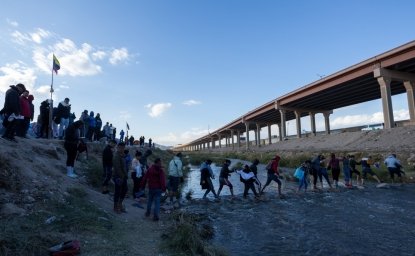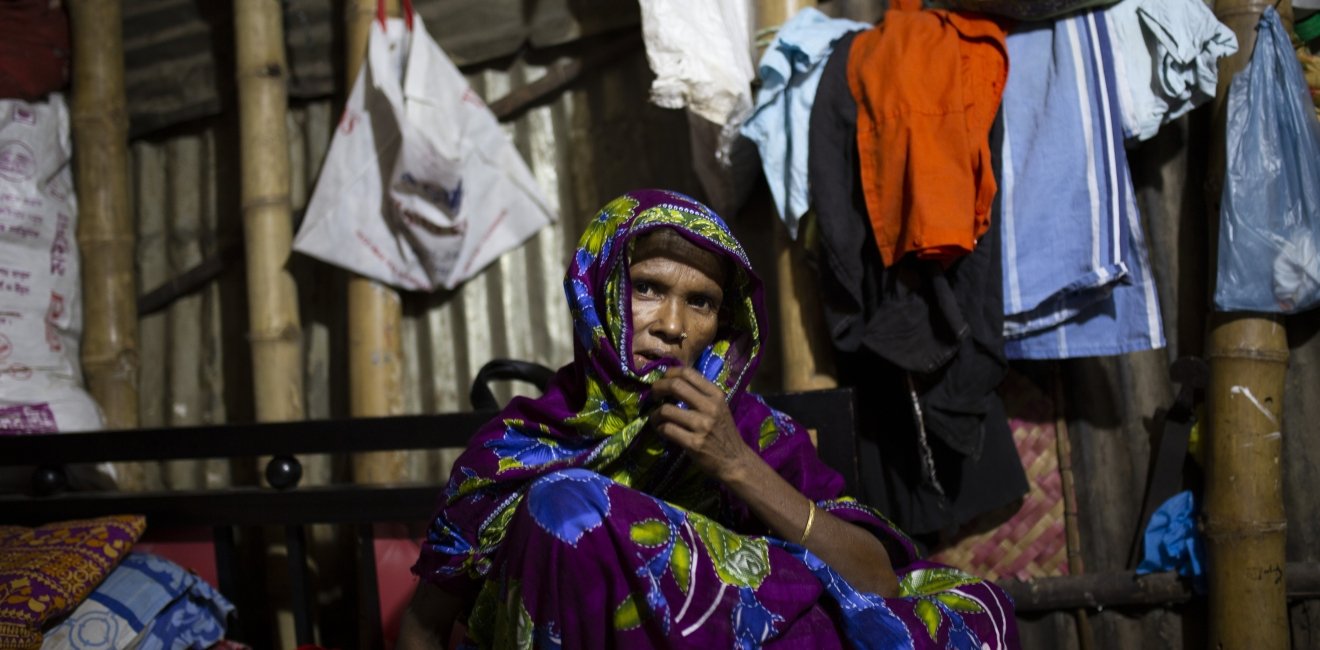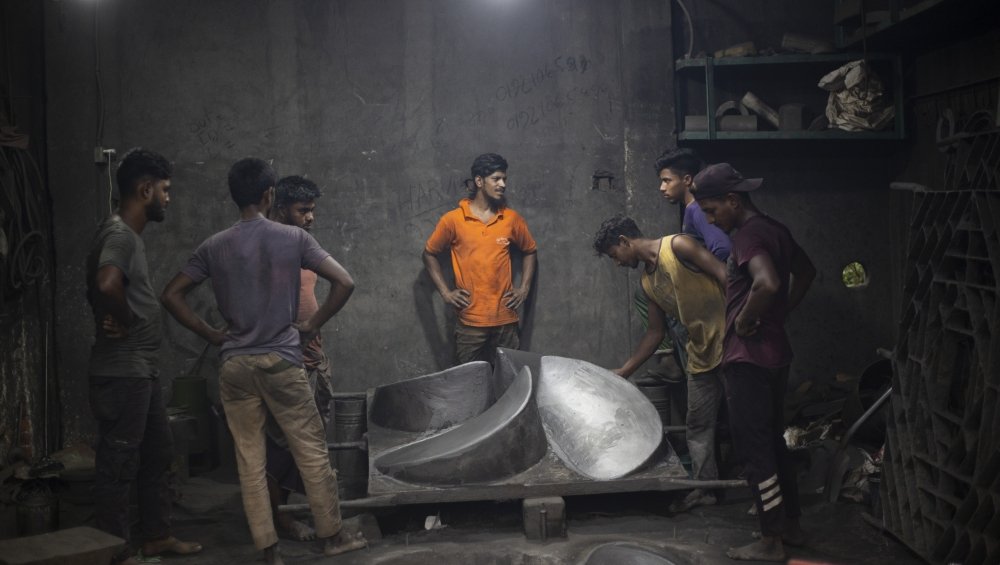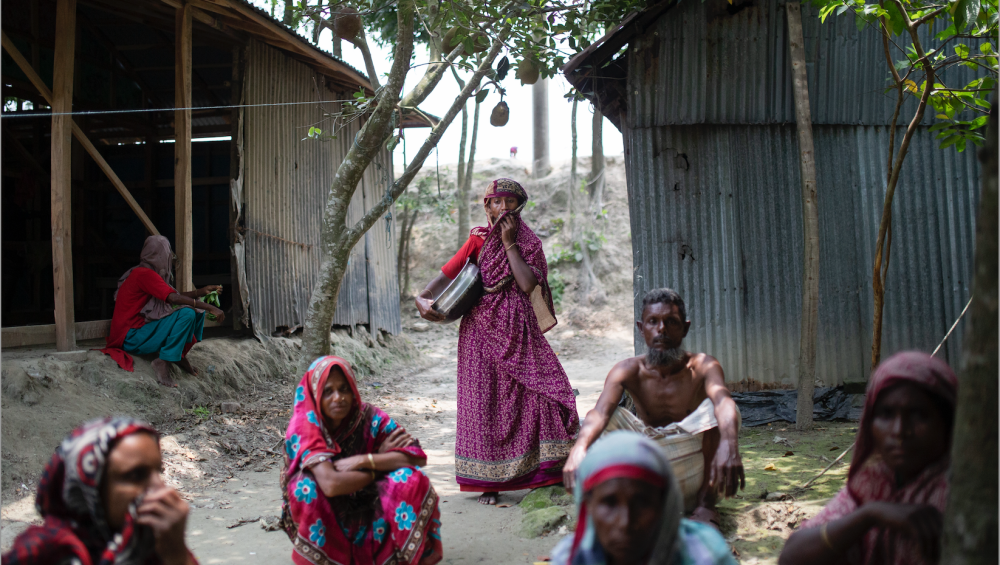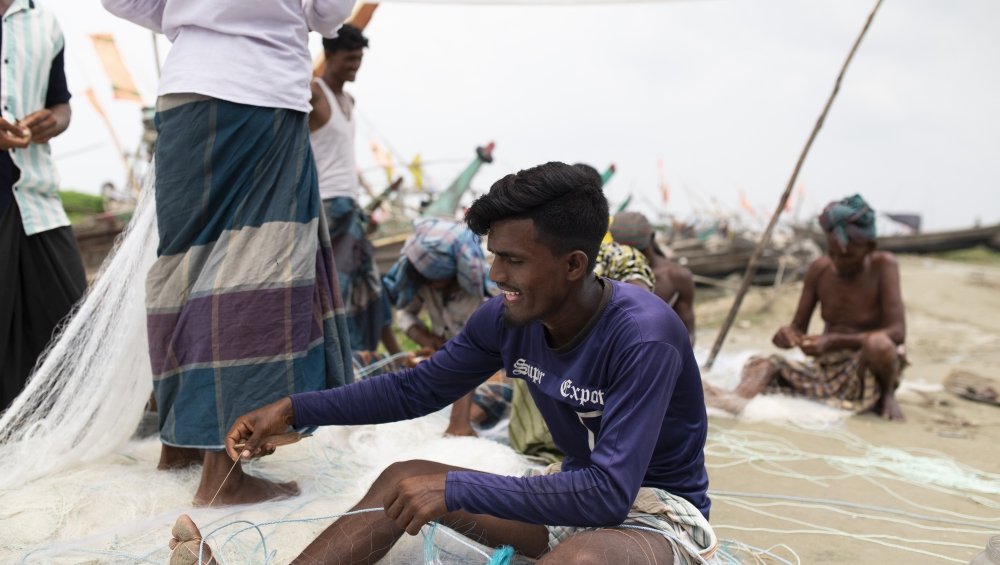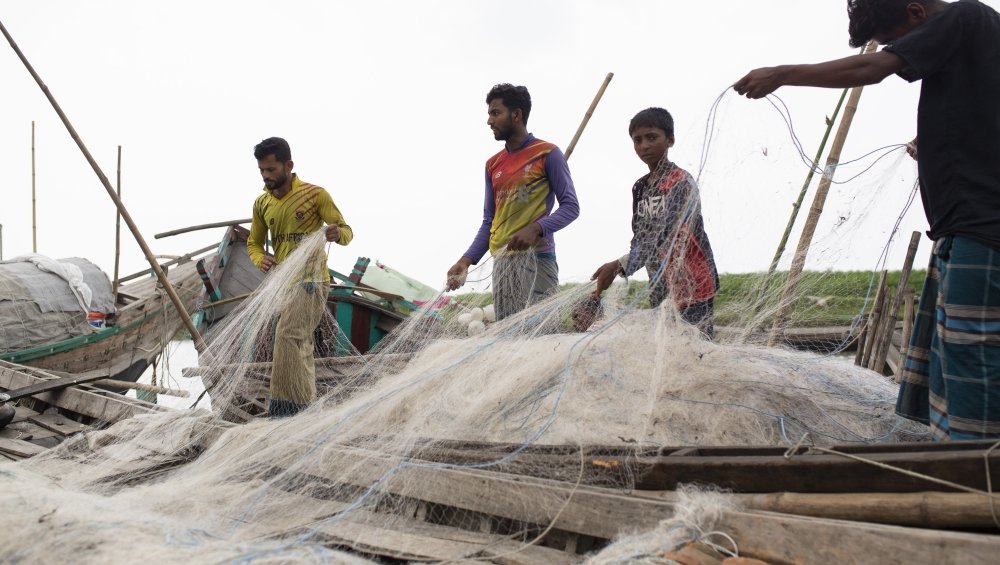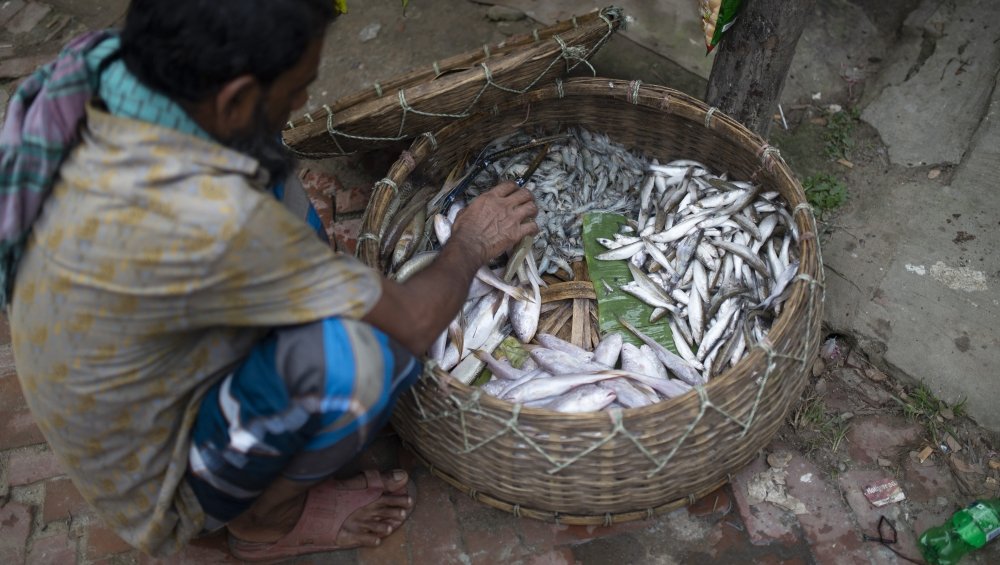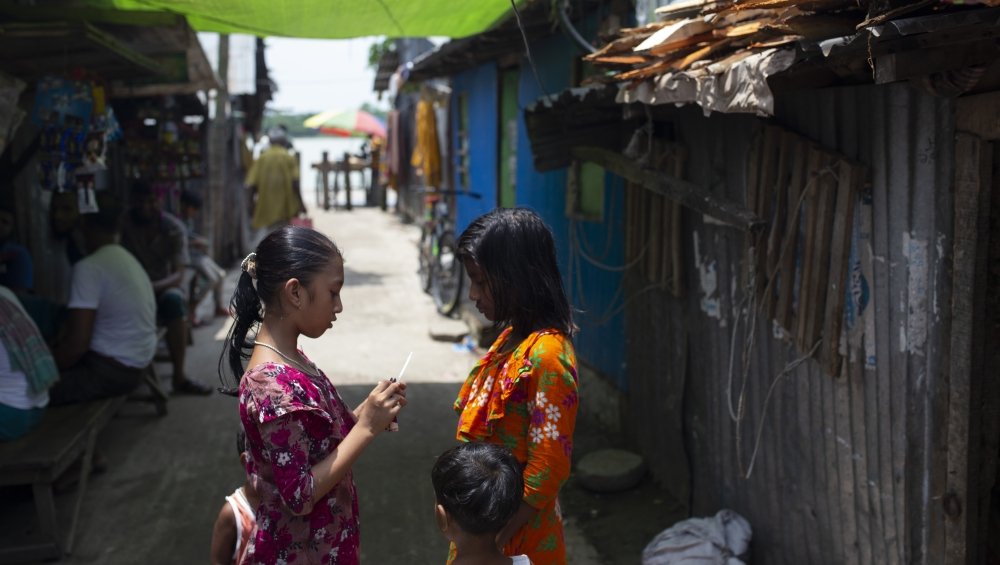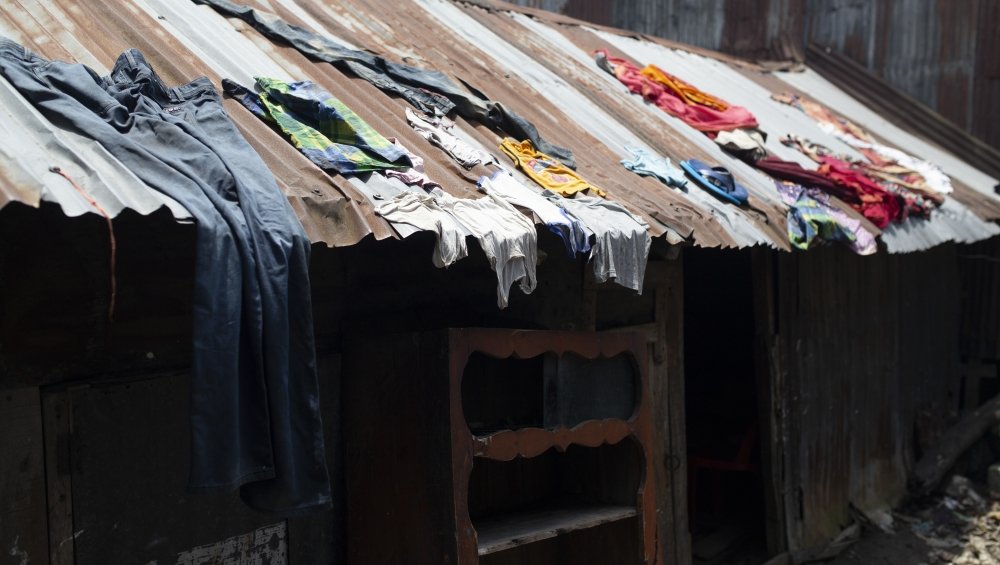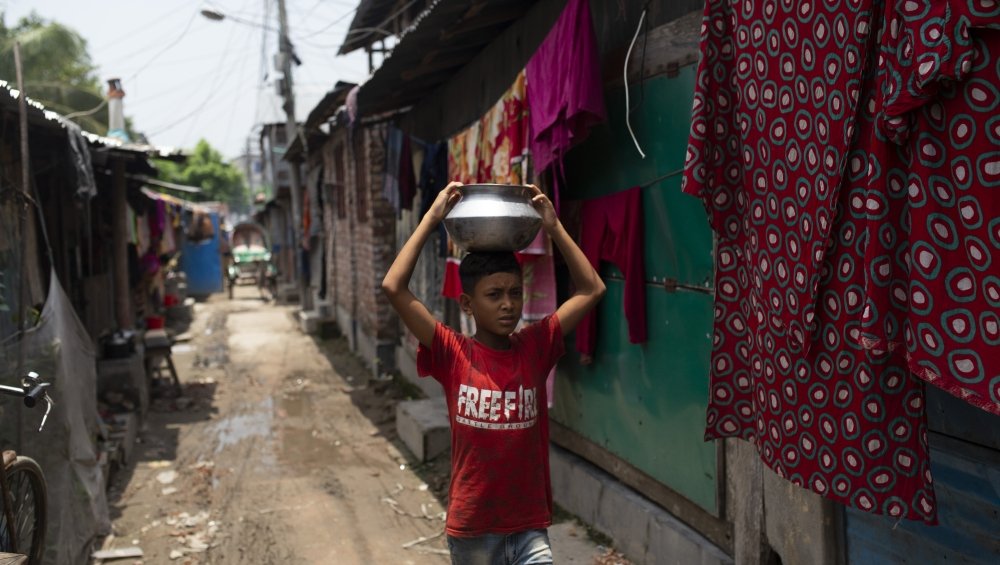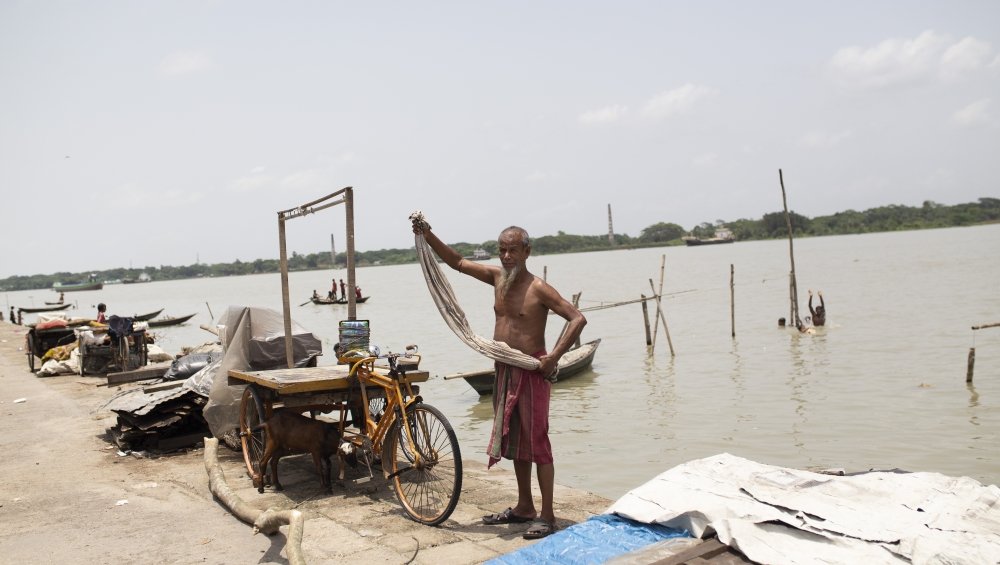For Tazara Begum, city life still feels like something of an adventure. Having arrived in Dhaka two months and 12 days ago (she’s counting), the 51-year-old is captivated by the noise, the height of the buildings, and the extraordinary bustle of this 25-million-person metropolis. She’s also enjoying catching up with friends and family who had migrated from coastal southern Bangladesh many years ago.
But none of that is to say she is happy to be there. Having lost her home to one of the country’s insatiable rivers, Tazara ultimately felt she had no choice but to join the roughly 1,200 others from her village who had already moved to the capital. The rest of the family – her husband, four sons, and their young children – will follow once she’s secured a space of their own in the Bhola community slum.
“We tried everything to stay. Everything.”
A taciturn woman who allows others to do much of her talking, Tazara won’t be drawn on the future. But on the subject of Elisha, her native village, she is voluble in the extreme. She misses the big skies, now largely invisible from her subterranean portion of the slum. She misses the food. The very idea that she might not see it again is almost enough to bring her to tears. “We tried everything to stay. Everything,” Tazara says, repeating the last word for emphasis. “But in the end, with our circumstances, with everything that was happening, we found it impossible.”
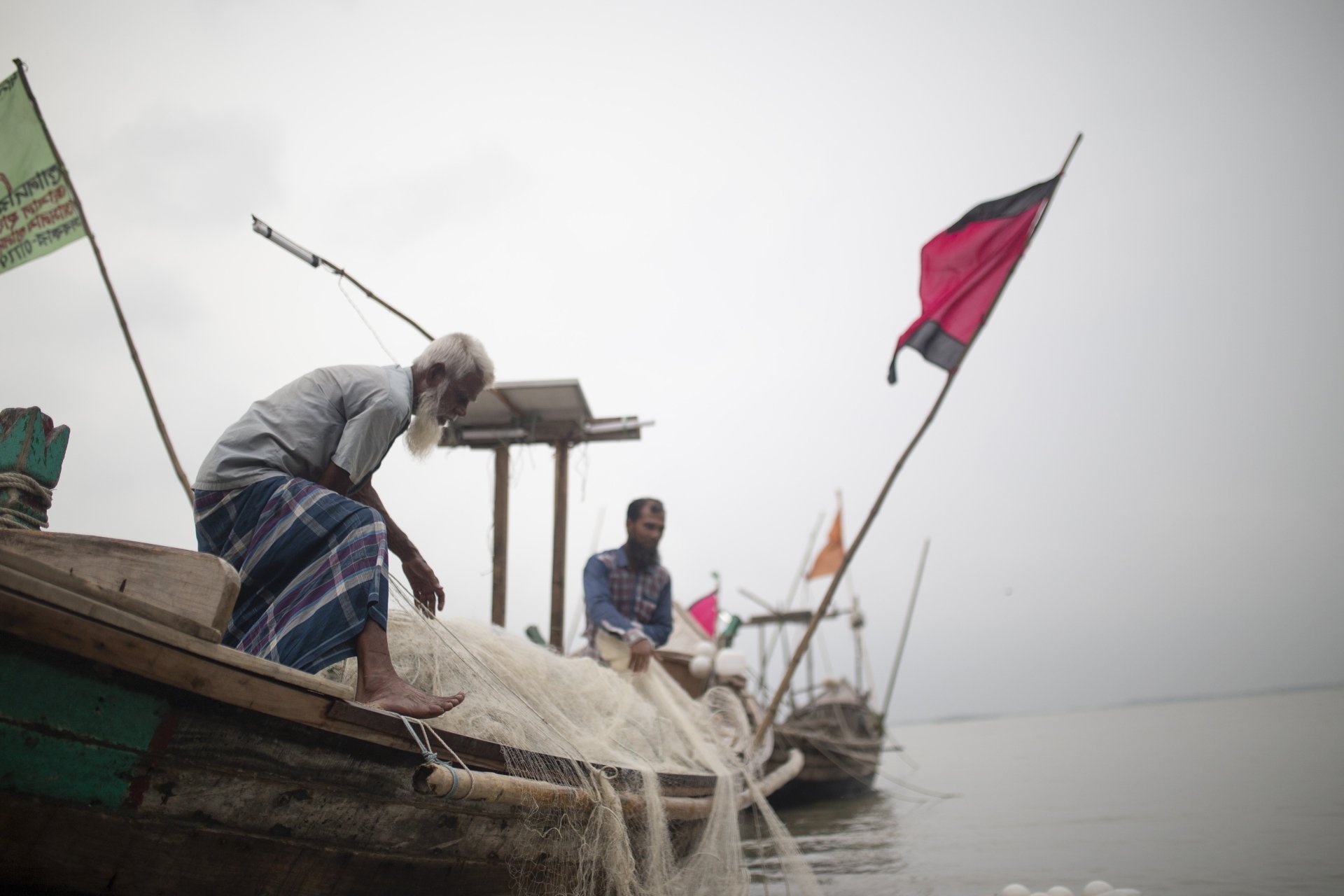
Bangladesh is often described as the centerpiece of global climate-related rural-to-urban migration, and to see the outflux from its battered villages it’s easy to understand why. Dhaka might already have been receiving 400,000 annual new arrivals from the countryside a decade ago, according to a study, more than 80 percent of whom listed environmental drivers as causes of displacement. Small towns are rapidly swelling into big ones, just as some secondary cities exhaust whatever space they had previously earmarked for decades’ worth of development. Barring a dramatic reduction in global emissions, the World Bank projects that the country will have 19 million internal ‘climate migrants’ by 2050, about half the South Asian total (and the biggest per capita displacement of any non-island state).
As a deltaic country with five major river systems and over 700 standalone waterways, Bangladesh is well-versed in at least some of this kind of displacement. Ninety-three percent of that water is generated beyond its borders, which means the country has frequently been confronted with more flood and erosion-inducing river flows than it can possibly handle. Over half the massive population – some 165 million people squeezed into an area the size of Illinois – lives less than five meters above sea level, leaving many of them acutely vulnerable to killer cyclones off the Bay of Bengal.
It’s this legacy of environmental woe – and urban attractiveness – that’s prompted some uncertainty as to how much mass migration is rooted in climate change. With more services and jobs and educational possibilities in the cities, as in most countries, rural Bangladeshis have long had good non-climate-related cause to gravitate towards urban centers.
But what’s happening now is a different beast and playing out on a grander scale to what the region has previously experienced, the country’s top scientists say. More Himalayan snowmelt has fueled more sustained and erratic river flows. That is contributing to more intense river erosion and flooding, likely the biggest sources of displacement. Rising seas are eating into densely populated coastal areas, with all the lost property and agricultural livelihoods that come with that. At a time of continuing population growth and fewer possibilities to secure rural land elsewhere, these climatic factors have combined to create a perfect storm for tens of millions of villagers. For many of them, urban migration can seem like best – or perhaps least unpalatable – response.
Monsoons and Misery
For Tazara and her family this move has been a long time in the making. Born shortly after the horror cyclone of 1970, which killed tens of thousands on Bhola island alone, she had watched, through her early adulthood, as her neighbors’ houses closer to the waterline tumbled into the Meghna river. She also had seen how little effect their structural reinforcements had had in stifling the advancing waters.
So when, one soggy monsoon day in 2011, the river finally came for her wood and sheet metal house, there was sadness and weariness and fear for the future, but little surprise.
“It was our home. It was dear to our heart. But we knew there was nothing we could do to stop this happening,” Tazara said.
According to a recent study, this stretch of coastal Bhola is among the third of Bangladeshi coastal communities that are intensely vulnerable to erosion.
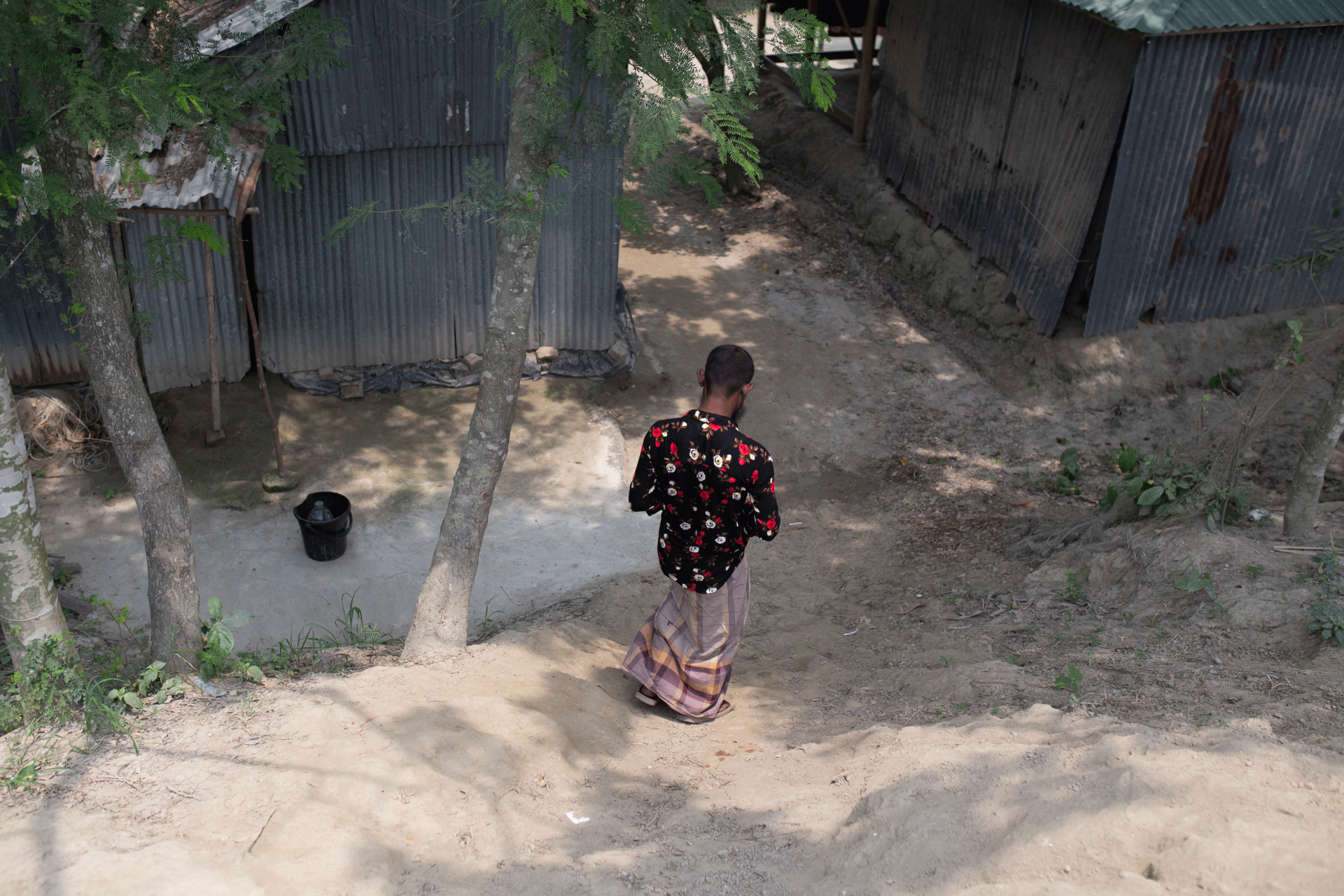
The Begums could, at that point, have followed her siblings to Dhaka. Three of them had lost their houses in the preceding years and migrated soon afterwards. But in initially choosing to remain in their home community, Tazara and her husband Abdulmaji were in good company. Over 90 percent of the 4,000 or so families that have lost their houses to river erosion in Elisha have remained in the area, according to local officials. Most have moved onto other family members’ land or, as in the Begums’ case, paid a landowner to erect a shack along the edge of one of his fields. Villagers say that it is mostly the comparatively affluent or the very poor who feel alternately equipped or compelled to risk out-migration.
But, year by year and through deepening poverty, Tazara found herself doubting that choice. The family, now without any land of its own, struggled to afford the fruits and vegetables they had once grown in their small garden. Their new shelter was both intolerably hot, tucked as it was in the airless shadow of an earth embankment, and very susceptible to flooding because it sat in a hollow. Most monsoon seasons they had to seek sanctuary under tarpaulins on the embankment for a least a month until the water subsided.
For fishermen, like Abdulmaji, increasingly skimpy hauls cut their already meager earnings, undermining the family’s dominant rationale for staying on after losing their house. With more people than ever trying their luck out on the water amid deteriorating agricultural conditions, average catches have collapsed to a point that wholesalers in Elisha can struggle to buy 20 kilograms of fish a day in the spring months, down from up to 400 kilograms in the past.
These troubles have been compounded by government measures designed to temper overfishing. Though necessary, a ban on dropping nets between March and July has hobbled the rivers’ dependents, particularly in the absence of promised state compensation. Abdulmaji began to migrate during the ‘off-season,’ finding work first in Cox’s Bazaar as a deep-sea fisherman and then in Chittagong and then in Dhaka. “There is an unpredictability to this life, but with city jobs you know you’ll get paid at the end of every day,” says Mohammed Riza, the Begums’ oldest son and also a fisherman.
The knockout blows for the family came in the early months of 2022. Abdulmaji had been banking on a grant of land on a char, one of the new islands that are forged from the same erosive processes that claimed their house. That application went nowhere, much to his disappointment—and in a wider context of reported land grabbing by politically-connected elites. Surging global prices pushed him – and much of the community – even deeper into debt to local NGOs, one of which started to push him for partial repayment. Now needing about $20 a day for boat fuel and other fishing expenses, Abdulmaji’s daily takings are insufficient to break even, especially once he’s accounted for the boat owner’s share. In late March, Tazara Begum boarded the overnight ferry for Dhaka, prepped for her first visit to a city of any kind.
Making the Best of Bhola
Strung along a narrow sewage-filled drainage canal in northwestern Dhaka, the Bhola slum is none of its residents’ idea of dignified housing. Clean water access is so limited that many of its girls have particularly poor menstrual hygiene, according to administrators at the local school. Fires are a constant risk within its maze of tightly packed one-room lodgings.
Tazara Begum seemed dazed as she recounted a recent struggle to extricate the body of an elderly neighbor who had died within their subterranean patch of the slum. Ironically, for people who have almost all been displaced by climate-related river erosion, Dhaka’s unprecedently humid heat has made their lives particularly intolerable. “Until a few years ago we were ok. But now look at us,” said Rehana Begum, Tazara’s younger sister. “Look how we sweat.”
Bangladeshi activists and lawyers say that displaced women and young girls face a rash of additional challenges, including higher than national average rates of child marriage and gender-based violence. Keen to reduce numbers within their tiny homes—and less subject, perhaps, to some law enforcement, many families marry off their daughters from the age of 15 or 16.
Yet through it all there’s no shortage of good cheer in this slum or others across the city. And a lot of that has to do with the groundwork prepared by previous generations of migrants. Because Dhaka has been the focal point for wantaway villagers for decades, almost everyone in Bangladesh has family or friends there to smooth the integration process and help new arrivals to secure jobs. In the Bhola slum, that mostly means as housemaids in the homes of wealthier urbanites for women and as day laborers for men.
“This area is full of people from our village,” Abdulmaji said. “There are familiar faces, old friends. This is what makes it bearable.”
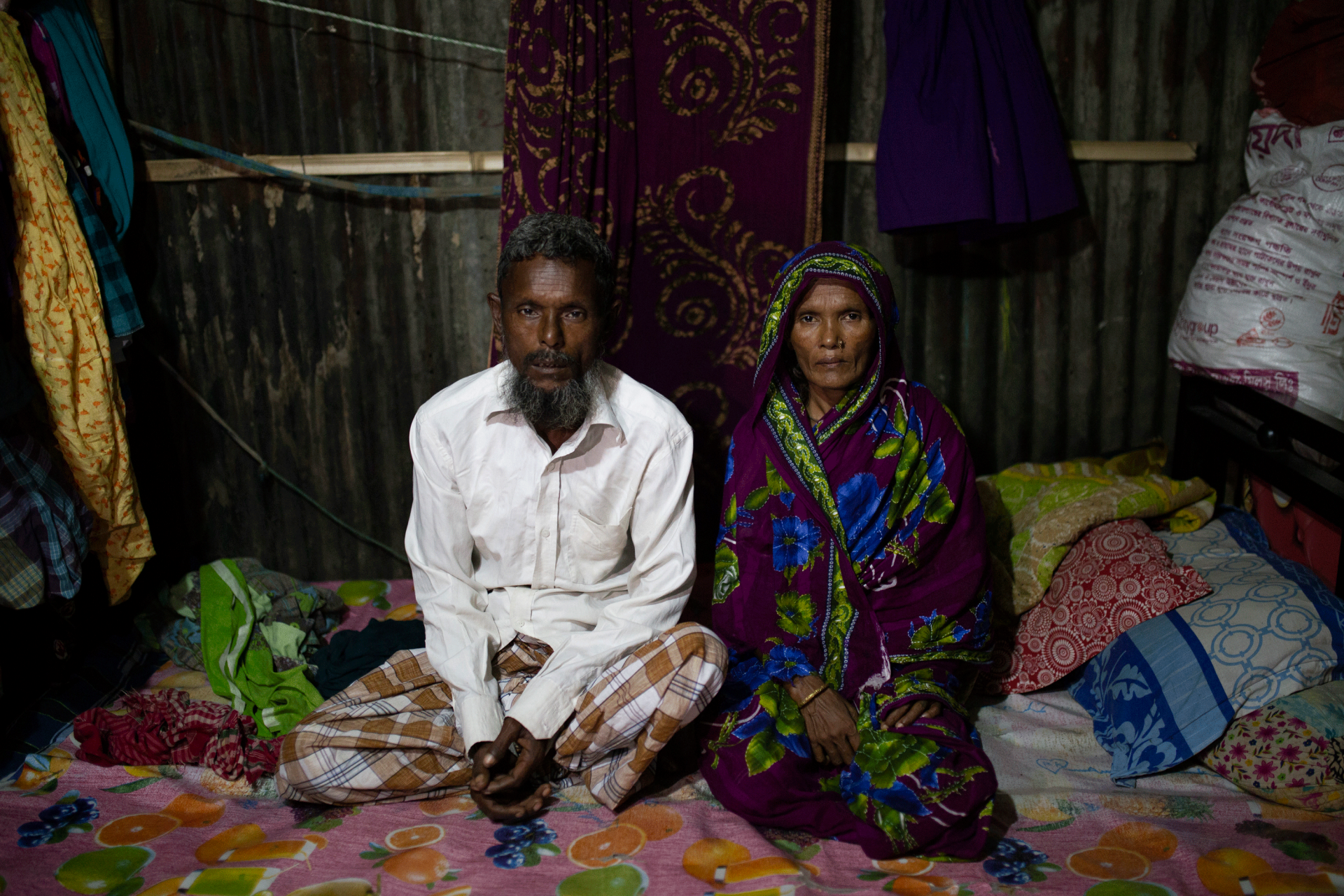
And because this kind of migration has become so normalized, the “fear factor” has mostly dissipated. Indeed, for all the difficulties in transitioning from life in a village to life in what might be the densest city in the world Tazara appears to be managing it with aplomb. In this, new arrivals are likely aided by Bangladesh’s relative ethnic and religious homogeneity, which means there’s little to distinguish rural migrants from longstanding urbanites and hence less discrimination, even when job-seeking ‘new’ Dhakans are accused of suppressing wages.
Crucially, most migrants display a stoic, largely uncomplaining acceptance of their fate. While some interviewees in the Bhola slum do express anger toward the million plus Rohingya refugees from Burma (whom they feel receive assistance that ought to go to needy Bangladeshis), most have been hardened to the bitter nature of displacement by the country’s history. There’s little talk of justice or equity or fairness, despite their country’s limited contribution to climate change.
“It’s God’s will,” Abdulmaji reasons. “Some people lose a little. We lost all,” says Tazara. “And we struggle. But this is how it is.”
Finding Room
Even after consuming half of Elisha’s land, pushing the Begums’ old house about a kilometer out into the river, the Meghna’s greed shows few signs of relenting. The river is breaking and contorting the community’s shoreline concrete block defenses – all a few short years after they were built. Recently placed geobags, sand-filled sacks designed to protect riverbanks at a fraction of the cost of concrete, have displayed uncertain results so far.
Bangladeshi hydrologists say that well-maintained embankments can temper erosion rates, but many are in anything but good order—and, vitally, few have been built with climate change in mind. And as storm surges strengthen and saline water intrusion into coastal farmland spreads, more Meghna-siders are bracing for displacement.
Against this grim-looking backdrop, authorities talk confidently about their communities’ capacity to adapt and survive. They say that the country’s success in softening the impact of cyclones can be applied to other environmental and climate-related crises. Through the construction of 12,000 new shelters and the rollout of enhanced early warning systems, the Bangladeshi state has significantly reduced casualties and, by extension, cyclone-induced migration.
These officials also point to villagers, like one of Tazara’s brothers, who migrated to Dhaka a decade ago and then made enough money to return to the island and establish a small business, as a sign of the countryside’s expanding economic appeal. “It’s not just agriculture now. We have a lot going on,” says Anwar Hossain Choton, the chairman of Elisha Union, akin to a mayor of a cluster of villages. Recent studies suggest that diversified rural economies are less likely to yield high rates of migration.
But as climate and other stresses bite, officials and businessmen elsewhere are alive to the probability of larger future rural in-flows. In Bhola town, the island’s administrative center, property prices have doubled on average since 2015, in part because of an influx from the coastal strip. In Barisal, a roughly half-million-person city two hours by boat from northern Bhola, existing slums are already filled to capacity with victims of river erosion, all part of a doubling of its population over the past two decades. In Dhaka, employers at the Buriganga river shipyards have many more job applicants than they can accept. Most of these men, they say, are displaced villagers who’ve come to the capital after failing to secure well-paying work in smaller cities. “Our city is a beast, as you can see, but conditions are bad in other places, so people keep coming,” said Asadou Jaman, a supervisor.
Amid dangerous degrees of overcrowding, especially since city authorities cleared two-thirds of the original site a few years ago, the Bhola slum won’t be accepting many of those future arrivals. However, from their cramped, often hellishly hot quarters, residents there hope that this enlarged wave of rural incomers will at least focus government minds’ on the necessity of providing more ‘dignified’ housing for the displaced. Tazara says she doesn’t mind whether that housing is in overwhelmed Dhaka, in smaller ‘migrant friendly’ communities elsewhere in the country, or, better yet, in less vulnerable parts of Bhola island. Her sister, Minara, a community slum leader, adds that the important thing is that they’re given a chance to do more than just survive.
“We don’t think this is too much to ask,” she insists. “Do you?”
Author

Environmental Journalist

Environmental Change and Security Program
The Environmental Change and Security Program (ECSP) explores the connections between environmental change, health, and population dynamics and their links to conflict, human insecurity, and foreign policy. Read more

Explore More
Browse Insights & Analysis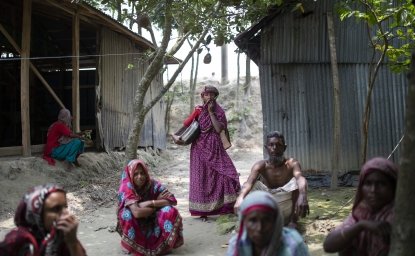
Climate & Migration
